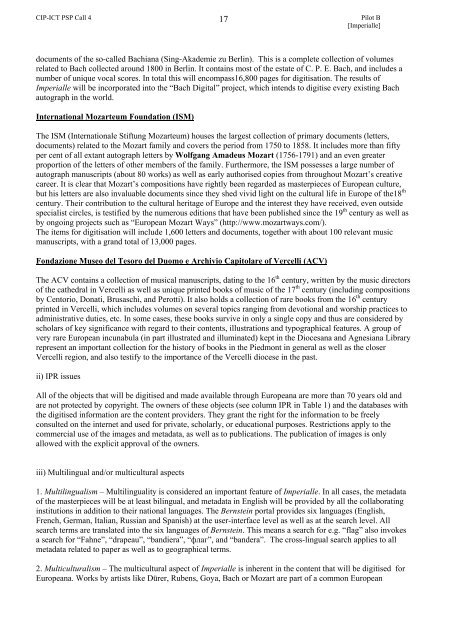proposal part b - The Bernstein Project
proposal part b - The Bernstein Project
proposal part b - The Bernstein Project
You also want an ePaper? Increase the reach of your titles
YUMPU automatically turns print PDFs into web optimized ePapers that Google loves.
CIP-ICT PSP Call 4 17<br />
Pilot B<br />
[Imperialle]<br />
documents of the so-called Bachiana (Sing-Akademie zu Berlin). This is a complete collection of volumes<br />
related to Bach collected around 1800 in Berlin. It contains most of the estate of C. P. E. Bach, and includes a<br />
number of unique vocal scores. In total this will encompass16,800 pages for digitisation. <strong>The</strong> results of<br />
Imperialle will be incorporated into the “Bach Digital” project, which intends to digitise every existing Bach<br />
autograph in the world.<br />
International Mozarteum Foundation (ISM)<br />
<strong>The</strong> ISM (Internationale Stiftung Mozarteum) houses the largest collection of primary documents (letters,<br />
documents) related to the Mozart family and covers the period from 1750 to 1858. It includes more than fifty<br />
per cent of all extant autograph letters by Wolfgang Amadeus Mozart (1756-1791) and an even greater<br />
proportion of the letters of other members of the family. Furthermore, the ISM possesses a large number of<br />
autograph manuscripts (about 80 works) as well as early authorised copies from throughout Mozart’s creative<br />
career. It is clear that Mozart’s compositions have rightly been regarded as masterpieces of European culture,<br />
but his letters are also invaluable documents since they shed vivid light on the cultural life in Europe of the18 th<br />
century. <strong>The</strong>ir contribution to the cultural heritage of Europe and the interest they have received, even outside<br />
specialist circles, is testified by the numerous editions that have been published since the 19 th century as well as<br />
by ongoing projects such as “European Mozart Ways” (http://www.mozartways.com/).<br />
<strong>The</strong> items for digitisation will include 1,600 letters and documents, together with about 100 relevant music<br />
manuscripts, with a grand total of 13,000 pages.<br />
Fondazione Museo del Tesoro del Duomo e Archivio Capitolare of Vercelli (ACV)<br />
<strong>The</strong> ACV contains a collection of musical manuscripts, dating to the 16 th century, written by the music directors<br />
of the cathedral in Vercelli as well as unique printed books of music of the 17 th century (including compositions<br />
by Centorio, Donati, Brusaschi, and Perotti). It also holds a collection of rare books from the 16 th century<br />
printed in Vercelli, which includes volumes on several topics ranging from devotional and worship practices to<br />
administrative duties, etc. In some cases, these books survive in only a single copy and thus are considered by<br />
scholars of key significance with regard to their contents, illustrations and typographical features. A group of<br />
very rare European incunabula (in <strong>part</strong> illustrated and illuminated) kept in the Diocesana and Agnesiana Library<br />
represent an important collection for the history of books in the Piedmont in general as well as the closer<br />
Vercelli region, and also testify to the importance of the Vercelli diocese in the past.<br />
ii) IPR issues<br />
All of the objects that will be digitised and made available through Europeana are more than 70 years old and<br />
are not protected by copyright. <strong>The</strong> owners of these objects (see column IPR in Table 1) and the databases with<br />
the digitised information are the content providers. <strong>The</strong>y grant the right for the information to be freely<br />
consulted on the internet and used for private, scholarly, or educational purposes. Restrictions apply to the<br />
commercial use of the images and metadata, as well as to publications. <strong>The</strong> publication of images is only<br />
allowed with the explicit approval of the owners.<br />
iii) Multilingual and/or multicultural aspects<br />
1. Multilingualism – Multilinguality is considered an important feature of Imperialle. In all cases, the metadata<br />
of the masterpieces will be at least bilingual, and metadata in English will be provided by all the collaborating<br />
institutions in addition to their national languages. <strong>The</strong> <strong>Bernstein</strong> portal provides six languages (English,<br />
French, German, Italian, Russian and Spanish) at the user-interface level as well as at the search level. All<br />
search terms are translated into the six languages of <strong>Bernstein</strong>. This means a search for e.g. “flag” also invokes<br />
a search for “Fahne”, “drapeau”, “bandiera”, “флаг”, and “bandera”. <strong>The</strong> cross-lingual search applies to all<br />
metadata related to paper as well as to geographical terms.<br />
2. Multiculturalism – <strong>The</strong> multicultural aspect of Imperialle is inherent in the content that will be digitised for<br />
Europeana. Works by artists like Dürer, Rubens, Goya, Bach or Mozart are <strong>part</strong> of a common European









